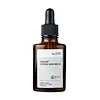What's inside
What's inside
 Key Ingredients
Key Ingredients

 Benefits
Benefits

 Ingredients Side-by-side
Ingredients Side-by-side

Water
Skin ConditioningPotassium Azeloyl Diglycinate
Skin ConditioningButylene Glycol
HumectantPropanediol
SolventPentylene Glycol
Skin ConditioningSodium Ascorbyl Phosphate
AntioxidantNiacinamide
SmoothingSodium Acetylated Hyaluronate
HumectantSodium Hyaluronate Crosspolymer-2
HumectantHydrolyzed Sodium Hyaluronate
Skin ConditioningSodium Hyaluronate
HumectantMelaleuca Alternifolia Leaf Extract
PerfumingCentella Asiatica Extract
CleansingScutellaria Baicalensis Root Extract
AstringentPolygonum Cuspidatum Root Extract
AntioxidantGlycyrrhiza Glabra Root Extract
BleachingCamellia Sinensis Leaf Extract
AntimicrobialRosmarinus Officinalis Leaf Extract
AntimicrobialChamomilla Recutita Flower Extract
MaskingXanthan Gum
EmulsifyingHydroxyethylcellulose
Emulsion Stabilising1,2-Hexanediol
Skin ConditioningEthylhexylglycerin
Skin ConditioningCalcium Sodium Borosilicate
Silver Oxide
AntimicrobialWater, Potassium Azeloyl Diglycinate, Butylene Glycol, Propanediol, Pentylene Glycol, Sodium Ascorbyl Phosphate, Niacinamide, Sodium Acetylated Hyaluronate, Sodium Hyaluronate Crosspolymer-2, Hydrolyzed Sodium Hyaluronate, Sodium Hyaluronate, Melaleuca Alternifolia Leaf Extract, Centella Asiatica Extract, Scutellaria Baicalensis Root Extract, Polygonum Cuspidatum Root Extract, Glycyrrhiza Glabra Root Extract, Camellia Sinensis Leaf Extract, Rosmarinus Officinalis Leaf Extract, Chamomilla Recutita Flower Extract, Xanthan Gum, Hydroxyethylcellulose, 1,2-Hexanediol, Ethylhexylglycerin, Calcium Sodium Borosilicate, Silver Oxide
Betula Platyphylla Japonica Juice 70%
Skin ConditioningButylene Glycol
HumectantDipropylene Glycol
HumectantWater
Skin ConditioningGlycerin
HumectantDiglycerin
Humectant1,2-Hexanediol
Skin ConditioningTrehalose
HumectantHydroxyacetophenone
AntioxidantCarbomer
Emulsion StabilisingCaprylyl Glycol
EmollientTromethamine
BufferingAllantoin
Skin ConditioningBetaine
HumectantCucumis Sativus Fruit Extract
EmollientGlyceryl Acrylate/Acrylic Acid Copolymer
HumectantDextrin
AbsorbentGardenia Florida Fruit Extract
Skin ConditioningOenothera Biennis Flower Extract
AstringentUlmus Davidiana Root Extract
Skin ConditioningBiosaccharide Gum-1
HumectantPinus Palustris Leaf Extract
TonicPanthenol
Skin ConditioningPueraria Lobata Root Extract
HumectantGluconolactone
Skin ConditioningDipotassium Glycyrrhizate
HumectantMalachite Extract
AntioxidantTocopherol
AntioxidantSodium Hyaluronate
HumectantHydroxypropyltrimonium Hyaluronate
Sodium Acetylated Hyaluronate
HumectantHydrolyzed Hyaluronic Acid
HumectantHyaluronic Acid
HumectantSodium Hyaluronate Crosspolymer
HumectantHydrolyzed Sodium Hyaluronate
Skin ConditioningPotassium Hyaluronate
Skin ConditioningSodium Phytate
Ethylhexylglycerin
Skin ConditioningBetula Platyphylla Japonica Juice 70%, Butylene Glycol, Dipropylene Glycol, Water, Glycerin, Diglycerin, 1,2-Hexanediol, Trehalose, Hydroxyacetophenone, Carbomer, Caprylyl Glycol, Tromethamine, Allantoin, Betaine, Cucumis Sativus Fruit Extract, Glyceryl Acrylate/Acrylic Acid Copolymer, Dextrin, Gardenia Florida Fruit Extract, Oenothera Biennis Flower Extract, Ulmus Davidiana Root Extract, Biosaccharide Gum-1, Pinus Palustris Leaf Extract, Panthenol, Pueraria Lobata Root Extract, Gluconolactone, Dipotassium Glycyrrhizate, Malachite Extract, Tocopherol, Sodium Hyaluronate, Hydroxypropyltrimonium Hyaluronate, Sodium Acetylated Hyaluronate, Hydrolyzed Hyaluronic Acid, Hyaluronic Acid, Sodium Hyaluronate Crosspolymer, Hydrolyzed Sodium Hyaluronate, Potassium Hyaluronate, Sodium Phytate, Ethylhexylglycerin
 Reviews
Reviews

Ingredients Explained
These ingredients are found in both products.
Ingredients higher up in an ingredient list are typically present in a larger amount.
1,2-Hexanediol is a synthetic liquid and another multi-functional powerhouse.
It is a:
- Humectant, drawing moisture into the skin
- Emollient, helping to soften skin
- Solvent, dispersing and stabilizing formulas
- Preservative booster, enhancing the antimicrobial activity of other preservatives
Butylene Glycol (or BG) is used within cosmetic products for a few different reasons:
Overall, Butylene Glycol is a safe and well-rounded ingredient that works well with other ingredients.
Though this ingredient works well with most skin types, some people with sensitive skin may experience a reaction such as allergic rashes, closed comedones, or itchiness.
Learn more about Butylene GlycolEthylhexylglycerin (we can't pronounce this either) is commonly used as a preservative and skin softener. It is derived from glyceryl.
You might see Ethylhexylglycerin often paired with other preservatives such as phenoxyethanol. Ethylhexylglycerin has been found to increase the effectiveness of these other preservatives.
This ingredient is created by putting sodium hyaluronate through hydrolysis.
You might know this as 'mini' or 'ultra low-molecular weight' hyaluronic acid. The small molecule size means it is able to travel deeper in the skin.
According to studies, low molecular-weight hyaluronic acid can:
One study from 2011 found ultra-low weight HA to show pro-inflammatory properties. Another study from 2022 found it to downregulate UV-B induced inflammation.
Hydrolysis is a process of changing a molecule using water or enzymes.
This ingredient is water-soluble.
Learn more about Hydrolyzed Sodium HyaluronateSodium Acetylated Hyaluronate is a type of Hyaluronic Acid.
Hyaluronic Acids help moisturize, soothe, and protect the skin.
Read about common types of Hyaluronic Acid here:
Sodium Hyaluronate
Hydrolyzed Hyaluronic Acid
Hyaluronic Acid
Sodium Hyaluronate is hyaluronic acid's salt form. It is commonly derived from the sodium salt of hyaluronic acid.
Like hyaluronic acid, it is great at holding water and acts as a humectant. This makes it a great skin hydrating ingredient.
Sodium Hyaluronate is naturally occurring in our bodies and is mostly found in eye fluid and joints.
These are some other common types of Hyaluronic Acid:
Learn more about Sodium HyaluronateWater. It's the most common cosmetic ingredient of all. You'll usually see it at the top of ingredient lists, meaning that it makes up the largest part of the product.
So why is it so popular? Water most often acts as a solvent - this means that it helps dissolve other ingredients into the formulation.
You'll also recognize water as that liquid we all need to stay alive. If you see this, drink a glass of water. Stay hydrated!
Learn more about Water